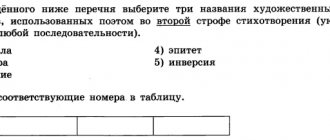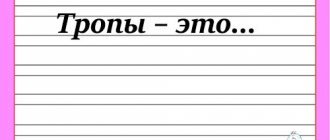Metaphor
Metaphor - trope; figurative expression; hidden comparison.
Usually expressed through a noun or verb.
For ease of understanding, we advise you to transform the proposed expression with a noun into a comparison (Golden, ripe fruits - fruits like gold), this way you will accurately define the metaphor. If the comparison (specifically with a noun) fails, then you made a mistake.
Functions of metaphor
- increased imagery;
- creation of special expressiveness.
| Examples: |
| “ The seething cauldron of the universe ” (the universe is like a seething cauldron); “And the sun’s yellow swords pierced the first hour of midday” (the rays of the sun are like yellow swords); “ The forest is full of silence . And yellow leaves. Flocks of birds left nature: the concert hall was left without artists ” (the forest as a concert hall); “Today there was a wonderful rain – Silver carnation with a diamond head ” (rain like a carnation) |
Litotes
Litota - trope; figurative expression; an understatement that emphasizes the lack of strength or weakening of the significance of some phenomenon.
Functions of litotes
- emphasizing the insignificance of a phenomenon;
- creation of special expressiveness;
- achieving a comic or satirical effect.
| Examples: |
| “I have lived a hundred lives without you, And I was with you only for a moment ”; “I go outcast, homeless and poorer than the last poor. ” |
Phonetic means
The term phonetic comes from the Greek word φωνή, which means “sound.” We are not talking about any sound - the knocking of a hammer, the barking of a dog or the rustling of leaves are not included in the scope of interests of phonetics; it deals with the sounds of human speech. Accordingly, phonetic means of expressiveness are based on the perception of speech sounds - phonemes.
There are three main phonetic means of expression.
- Alliteration. It implies the use of the same type of consonant sounds in a limited passage of text (for example, within a quatrain).
The forest slumbers under the fairy tale of sleep. (S. Yesenin)
A variant of the technique is the use of words starting with the same letter - “Scandinavian alliteration”, which is especially popular in English-language literature. An example is, in particular, the characters of “Harry Potter” by J. Rowling, whose first and last names begin with the same letter (Severus Snape, Hermione Granger, etc.), or posters with public service announcements from “The End of a Chapter” by J. Galsworthy (“ The betting is a waste of thousands."
- Assonance. Using the same vowel sounds within a line, stanza, or sentence.
Breathing in perfumes and mists, she sits by the window. (A. Blok)
- Onomatopoeia. Transmission using phonetic means of sounds of the surrounding world - thunderclaps, the sound of horse hooves on cobblestones, the rustling of tires on the road or mice in the underground.
And the thunder roared continuously, and the winds raged in the wilds. (K. Ryleev)
The use of phonetic techniques is called sound writing, since with the help of the selection of phonemes in a literary work, a bright, “voiced” picture is drawn that stimulates the reader’s imagination.
Paronyms - what are they, examples
Hyperbola
Hyperbole is a trope; figurative expression; exaggeration that sharply emphasizes the strength or significance of some phenomenon.
Hyperbole is a figurative and expressive means opposite to litotes.
Hyperbola functions
- achieving a comic or satirical effect;
- emphasizing the predominance of a phenomenon over others;
- creation of special expressiveness.
| Examples: |
| “I lived a hundred lives , And I was with you only for a moment.”; “I, and you too, have eternity in reserve ...”; “ In a hundred and forty suns the sunset was burning ”; “If I wake up before the sun and wake up at midnight, then I’ll crush the mountain. ” |
Periphrase
Periphrase - trope; figurative expression; replacing the name of a phenomenon or the name of a person by describing their essential features or indicating their characteristic features.
Paraphrase functions
- designation of a person, phenomenon, object;
- expression of the author's position;
- richness of speech by avoiding repetition.
| Examples: |
| “Here the horde followed the horde. Bringing fire and chains !” (fire and chains - war); “So to speak, a slave of honor ... struck down by a bullet...” (slave of honor - Pushkin); “ The Volga Stronghold , But the blind huts cannot be helped” (Volzhskaya Stronghold - Volgograd) |
Allegory
Allegory is a trope; figurative expression; transfer of meanings from one subject to another; — isolation of concepts through an artistic image.
Functions of allegory
- increased imagery;
- creation of special expressiveness.
| Examples: | |
| Allegories can be introduced by the author from old fables and fairy tales, since they arose on the basis of myths. | |
| Fox | deceit |
| Wolf | greed |
| Snake | deceit |
| Bird | freedom, liberation |
| Libra, Themis | justice, impartiality |
| Scythe, Hades | death |
Personification
Personification - trope; figurative expression; endowing inanimate objects with the properties of animate ones (the ability to think, speak, feel and act).
Impersonation functions
- increased imagery;
- creating expressiveness;
- reflection of the author's position through the choice of associative series.
| Examples: |
| “For the first time , the moon these chains and trembling... Sculpts a bust not sculpted by anyone”; “Spring, I’m from the street, where the poplar is surprised , Where the distance is afraid , Where the house is afraid to fall ,”; “And the streets of ancient Prague are silent , winding one another, But they play like ravines .” “Turning its face to the south, the Pine squints in the sun .” |
Oxymoron
Oxymoron (Oxymoron) - trope; figurative expression; connection of two contradictory meanings; connection of the incompatible.
Functions of an oxymoron
- focusing readers' attention;
- unusual reflection of feelings;
- expresses the thoughts of the poet/lyrical character about the presented phenomenon
| Examples: |
| “He lies to you so richly and so poorly !”; “ The eternal moment ”; “ I ask the beggar for bread , I give to the rich for poverty , ... I hand over the key to the robber , I blush the pallor with whitewash .”; “Even then there was no place ! Even then on earth there was a home for me everywhere .”; “And in my eyes there is always Hot snow , bloody snow” |
Metonymy
Metonymy - trope; figurative expression; replacing one word or expression with another based on similar meanings.
Functions of metonymy
- noticeable shortening of the author's thoughts;
- increased expressiveness.
| Examples: |
| “ Egypt went home ” (not Egypt, but the inhabitants of Egypt); “Tormented by the madness of Melpomene , in this life I thirst only for peace...” (not by Melpomene herself, but by the tragedy played in the theater (Melpomene is the muse of tragedy)). “ No one will offend the Field of Gaia “If not on silver, I ate on gold ” (not on gold in the literal sense, but on dishes made of gold); “ Watercolor in the grip of an old baguette seemed dull ” (baguette - frame made of baguette); “ Hearing the smell of foam ” (foamy is alcohol). |
Repeat
Repetition is a trope; figurative expression; partial or complete repetition of a word, expression, line.
Repeat functions
- sound recording enhancement;
- strengthening the quality of an object, phenomenon;
- emphasis on quantity, duration;
- achieving emotional impact.
| Examples: |
| “ Trucks sleep cranes sleep “And spins , we, the stars, and the whole ocean spins round and round .”; “But don’t be angry with me , Nadya, and don’t be angry with me , Martha.”; " We are Russians. We are children of the Volga." |










